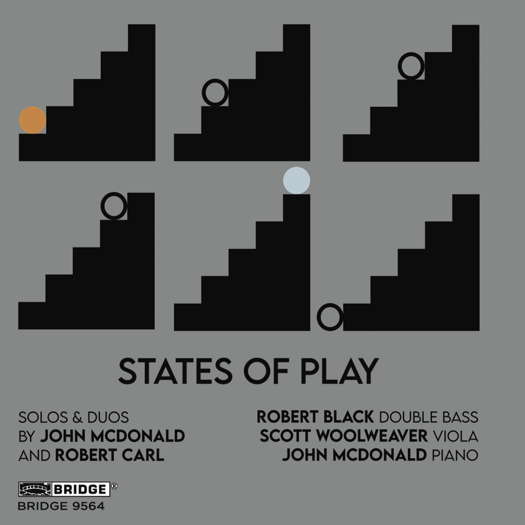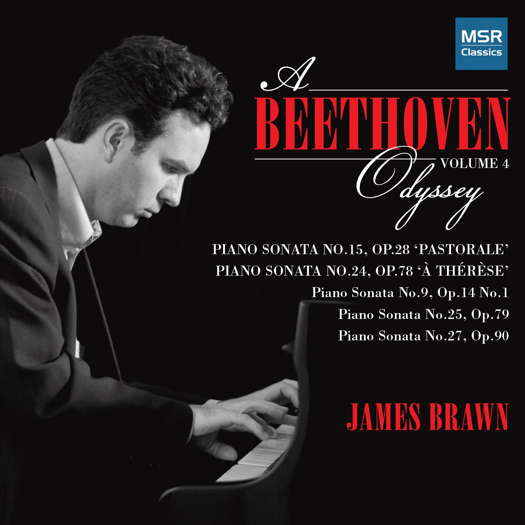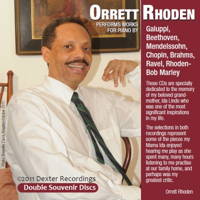- Marcello Giordani
- Stanislaw Skrowaczewski
- Francis Caporale
- Henri Dutilleux
- Anna Thorvaldsdóttir
- Bampton Classical Opera
- Foundling Museum
- Negro Melodies

The Community Behind the Voice
JOHN DANTE PREVEDINI listens to music by Robert Carl and John McDonald
'... a rich, joyous and life-affirming tribute to the role of community in shaping the artistic voice.'
States of Play is the recent release from Bridge Records featuring a collection of piano solos and duos composed by Robert Carl and John McDonald and performed by McDonald on piano, Scott Woolweaver on viola and Robert Black on double bass. The release has a running time of sixty-six minutes, is available in both CD and digital format and is accompanied by extensive liner notes written by the two composers. Given the nature of the release as a multi-decade retrospective, it is perhaps fitting that the liner notes are extensive and somewhat autobiographical. Taken altogether, these pieces represent over thirty years (1987-2018) of collaboration and mutual artistic influence, not only between Carl and McDonald, but also among the composers and their various colleagues, mentors and students mentioned in the liner notes as instrumental in shaping the compositional voices heard on this album.
I would like to note that I did study composition with Robert Carl for about a year, several years ago; however, since I was not previously familiar with any of the music on this release and do not know anyone else involved in the project, I feel I have enough distance from the subject matter to reflect on it in a clear and balanced manner. One thing I will say about Carl's music, which I believe will help illuminate my analysis of the present album, is that his current harmonic practice is based on a highly individualistic harmonic language which treats chromatic passages as partials in the upper registers of a harmonic series (approximated by equal temperament), arising above various 'fundamentals' heard in the bass. In this way, Carl attempts to philosophically reconcile dissonant and consonant methods of harmonic thinking. As for John McDonald, the biographical section of the album liner notes specifies that he is a composer, a pianist and a Tufts University professor who specializes in such strikingly diverse specialties as 'writing music for young and non-professional performers' and 'music applications for visual art and science' among others.
The album opens with From the Ground Up, for solo piano. The piece captures the genesis of Carl's current harmonic practice, treating the material with enough registral space and pedaling in the piano to allow the resulting harmonies to resonate. As a result, their harmonic-series relations become clearer and more powerful. Next is Snowfall in two Parts, for solo piano, by John McDonald. The first movement, Does Snow Fall the Same Way on the Piano?, is a programmatic depiction of winter light and wind-blown snow which is achieved through a rapid alternation between two musical ideas that develop in parallel worlds, one slow and one scurrying. The second movement, October Snow on Gulf Road, is a swelling, lyrical and quasi-diatonic passage that recalls the slow theme of the first movement. The two short movements are presented together on one single track. The third piece, Surge for double bass and piano, is described by Carl as an early work which predates his overtone-based harmonic practice. Indeed, the unifying factor here seems, rather, to be the exploration of instrumental timbre, while its formal and harmonic structures seem to be organized along principles of more conventional minimalism and modernism.
Listen — Robert Carl: Surge
(BRIDGE 9564 track 3, 0:00-0:30) ℗ 2022 Bridge Records Inc :
Next is Blues Box for solo piano. Carl describes this work as a fusion of rigorous serialism and a blues-inspired spontaneity struggling to break free from its serial constraints. As an artifact of Carl's transition from his minimalist/modernist period to his current harmonic-series period, roughly contemporaneous with From the Ground Up, this piece strikes me as a fascinating alternative side of his lifelong efforts in the reconciliation between harmonic consonance and chromatic atonality. We then hear the two movements of Excavating the Perfect Farewell for piano and viola. The first movement, Digging, introduces a meditative and primal soundscape constructed from minimal means.
Listen — Robert Carl: Digging (Excavating the Perfect Farewell)
(BRIDGE 9564 track 5, 0:00-0:30) ℗ 2022 Bridge Records Inc :
Following this, we hear the second movement in response, Leave-Taking, a gradual development of the themes from the opening movement in a delicately balanced, spacious and highly lyrical framework. Next is At Pelham Lookout, Thinking About Impending Difficulties by John McDonald, the sonic equivalent of a sketch portrait which the composer describes in the liner notes as capturing the moment a colleague of his (unnamed in the notes) was gazing out over a landscape reflecting upon his own professorship tenure review.
Listen — John McDonald: At Pelham Lookout
(BRIDGE 9564 track 7, 0:00-0:30) ℗ 2022 Bridge Records Inc :
This is followed by Carl's solo piano work What's Underfoot, a microcosm of his entire overtone-based practice, in which a shifting field of high-register chromatic clusters gradually reveals itself to be the upper partials of a sequence of overtone series. Lower registers of the pitch soundscape are slowly revealed until, by the end, we hear the fundamentals of these overtone series in the bass, unveiling to us the hereto unforeseen context of consonance in which the dissonant upper-register clusters live. Carl shares in the liner notes that the concept of this piece was in fact inspired by the work of one of his own students, who had developed a new interpretation of this same overtone technique.
The album closes with the recent work A Gift ... And An Invitation!, in two movements for solo piano. Carl explains that this work is in response to a custom practiced by his colleague, the American composer Neely Bruce, of using a cipher method to encode the names of friends into fugues as a gift to them. In keeping with Bruce's tradition, Carl has written a 'Neely Bruce'-themed fugue in Bruce's own style, complete with a freely improvised prelude on the fugal subject. As the pianist, McDonald himself improvises the prelude heard on this recording. The fugue that follows has a language which seems somewhat rooted in traditional contrapuntal practice during the exposition section, after which the piece explores lyrical homophonic passages that develop the fugal subject through freer textures before a very brief recapitulation in the opening contrapuntal style.
In conclusion, I find this album to be a rich, joyous and life-affirming tribute to the role of community in shaping the artistic voice. From mentors and colleagues to collaborators and students alike, the album explores the essential role of human relationships in informing how artists explore the world around them, ask questions and test the limits of media within the artistic traditions they inherit. Lastly, the album embodies the kind of inclusive and cooperative spirit for which I often thirst amidst the adamant cultural standoffs that seem to define the ethos of our times. I will make a point of remembering and revisiting this album for years to come.
Copyright © 5 January 2023
John Dante Prevedini,
Connecticut, USA





